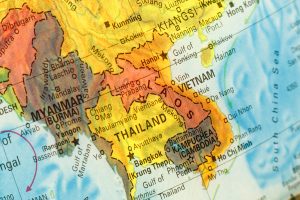Recent Thai-language articles on the state of Thailand’s economy tend to do one or both of the following things. First, they reference the “boiled frog syndrome” to illustrate that, just as a frog in gradually warming water fails to detect the rising heat and is eventually cooked alive, Thais may not notice incremental changes – such as declining purchasing power among the middle and lower classes and the shutdown of small and medium-sized businesses due to high operating costs – until it’s too late. Second, they portray Vietnam as a peer or step-ahead competitor of Thailand.
As Asia’s rising star, Vietnam has naturally drawn widespread attention regionally and globally. Nevertheless, Thailand’s focus on Vietnam’s growth is almost laser-like because, beyond historical rivalry, Vietnam threatens to outstrip Thailand’s established dominance in several export categories.
The electronics industry constitutes roughly 16 percent of Thailand’s total exports, which in turn make up as much as two-thirds of the country’s gross domestic product. Hard disk drives (HDDs), of which Thailand is a major producer globally, are key contributors to exported electronic goods. The concern is that despite predicted growth, HDDs may soon fade into the background as technology advances. This uncertainty provides further impetus for Thai policymakers to refocus and pursue a greater presence in the burgeoning semiconductor sector. Unfortunately for Thailand, not only is progress limited without better incentives for attracting chip manufacturing factories, but Vietnam has also thrived as a production base for downstream electronics, with a comprehensive plan to train 50,000 semiconductor engineers by 2030 and establish an investment fund for high-tech industries.
The rice battle is nothing new. Since losing its place as the world’s top rice exporter to India in 2012, Thailand has been vying with Vietnam for the runner-up spot. Although Thailand has been leading more than losing, signs of late point to brighter prospects for Vietnam. At the World’s Best Rice competition late last year, Vietnamese rice claimed the crown while Thai rice was absent, reflecting Thailand’s relative lack of research efforts. Unsurprisingly, then, Indonesia and Singapore have shown a growing preference for Vietnamese rice.
Durian exports to China mark a new and growing arena of competition. In 2022, Thailand supplied around 95 percent of the fresh durians to China, with Vietnam accounting for the rest. Yet, in 2023, Vietnam’s share (35 percent) was substantially higher, reducing Thailand’s share (65 percent) considerably. Benefiting from closer proximity to China, Vietnam’s share is projected to grow even more.
Discouraging news for the Thais doesn’t end in the economic realm. The fact that top world leaders – Joe Biden, Xi Jinping, and Vladimir Putin – showed up in Vietnam within a span of less than a year in 2023 and 2024 speaks volumes about Hanoi’s growing confidence and the effectiveness of its “bamboo diplomacy.” As Ian Storey of the ISEAS-Yusof Ishak Institute noted, Putin’s visit didn’t harm Vietnam-U.S. relations since Hanoi didn’t support Russia’s endeavors in Ukraine. In contrast, Xi’s 2022 visit was the last by any of the mentioned leaders to Thailand – the traditional master of bamboo diplomacy, certified by its uncolonized history.
What’s more, Thailand’s famed political scientist Panitan Wattanayagorn observed that Vietnam’s diplomatic showcase is a practical application of the “Strategic New Equilibrium” concept introduced by former Thai leader Prayut Chan-o-cha at the 2016 Shangri-La Dialogue. The concept essentially calls for enhanced engagement with all great powers in mutually beneficial areas of common interests to avoid choosing sides.
Underlying the above developments are likely the deep-rooted structural differences between Thailand and Vietnam. Whereas Thailand’s population is graying rapidly and understandably demanding a higher minimum wage, Vietnam is demographically comparatively young, and labor costs are lower. Moreover, unlike the apparently more predictable one-party rule of communist Vietnam, Thailand’s unstable democratic politics combined with bureaucratic rigidities incentivize those in power to focus on short-term stimulus (and largely populist) packages instead of committing to long-term reforms, especially those necessary for developing human resources. And even with a desire for a greater diplomatic presence, Thailand’s non-confrontational nature, minimal external security threats, and inward focus on domestic and economic priorities just don’t compel the country to act proactively and potentially invite any trouble.
While some of Thailand’s structural problems are fixable, others are not. The Thai media’s spotlight on Vietnam might ultimately be intended to nudge the government into taking meaningful action where possible.
One might expect that growing competition would lead to reduced cooperation, but this is not the case for Thailand-Vietnam relations. In fact, cooperation is on the rise across all areas, which makes sense considering the absence of strategic conflict between the two nations following their maritime delimitation in the 1990s. It’s also worth mentioning that historical rivalry with Vietnam is marginal from the Thai perspective, which views Myanmar as a historical nemesis and Cambodia as less trustworthy, all of which are reflected in the Asia Foundation’s newly-released survey on Thai public views on international issues.
Within ASEAN, Thailand is Vietnam’s largest trading partner and second-biggest investor, with some 66 percent of Thai companies seeking expansion. Vietnam, meanwhile, is Thailand’s second-largest trading partner in ASEAN after Malaysia, and an emerging investor. On tourism and connectivity, Thailand and Vietnam have agreed to increase flight connections, particularly between second-tier destinations, and to improve roads and coastal sea routes, which would benefit other countries in the Greater Mekong Subregion. On security, both Thailand and Vietnam face concerning challenges from illegal, unreported, and unregulated fishing and transnational crimes like scam call operations, making these key areas of increasing cooperation.
Strategic partners since 2013, Thailand and Vietnam are expected to soon formally announce an upgrade of their relationship to a comprehensive strategic partnership (CSP), the highest tier in Vietnam’s diplomatic hierarchy. Once finalized, Thailand would be the first ASEAN nation to enter a CSP with Vietnam, placing it among seven other major powers with similar agreements.

































